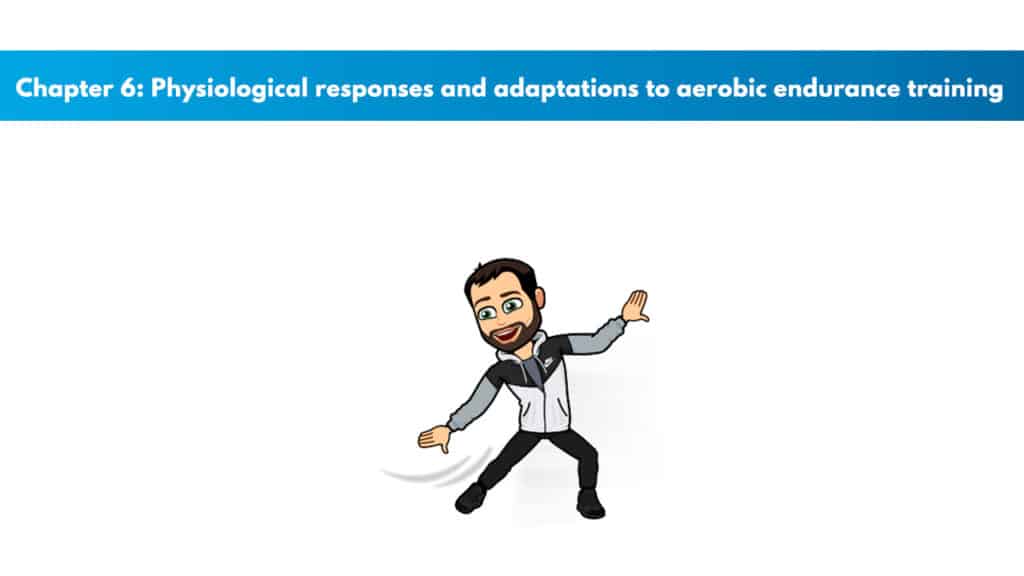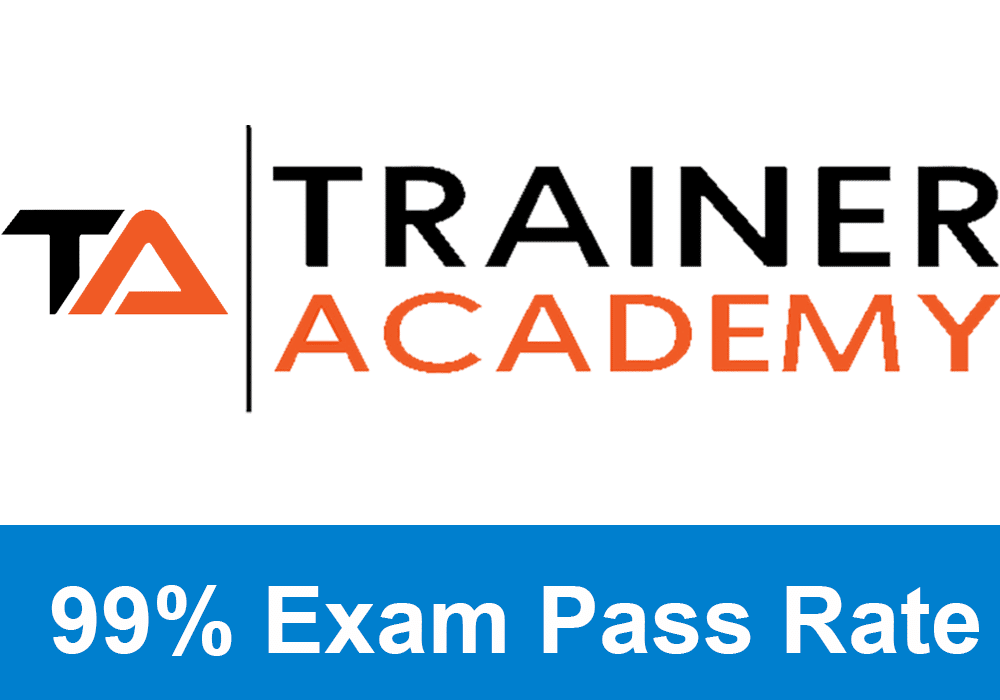
Get your copy of the NSCA CPT exam cheat sheet.
It helps immensely in studying for the NSCA-certified personal trainer exam and is provided by a veteran company in study materials, Trainer Academy.
My PTP students report cutting their NSCA study time and effort in half with Trainer Academy.
Benefit from the Exam Pass Guarantee and Retake Fee Guarantee. Plus, take advantage of my current discount code PTPJULY for 35% off the MVP Program (Ends July 21st, 2025).
Try it out for free here to see if it’s right for you, or read my detailed review for further insights.
Chapter Objectives:
- Find acute physiological responses to aerobic exercise.
- Find chronic physiological adaptations to aerobic endurance training
- Know the factors influencing adaptations to aerobic endurance training.
- Know and find the physiological factors that go with overtraining.
- Know the physiological consequences of detraining.
Acute Responses to Aerobic Endurance Exercise
Cardiovascular Responses
Two components are affected: the heart and the vasculature
While exercising, we have an increased stimulation or excitation of the heart occurring to supply blood to the working skeletal muscles.
Stroke volume increases to maximal levels at 40 – 60% VO2 max and plateaus long before exhaustion.
The Frank-Starling Mechanism says that the heart’s stroke volume increases proportionally to the volume of the blood that is filling the heart.
As we increase from resting states to max exercise intensity, we have a 50 – 60% reduction in total peripheral resistance. This reduction happens from vasodilation from efforts to supply the working skeletal muscles with what they need.
Blood to the body’s other parts is decreased during this exercise.
Blood pressure is the force exerted on blood vessels. Systolic blood pressure is the force when contracting and Diastolic blood pressure is the force when resting.
Mean arterial blood pressure rises during exercise and is expressed in numbers by the formula MAP = DBP + (0.333 X (SBP – DBP))
Rate pressure product shows how. Much oxygen the heart needs. The formula is RPP = HR X SBP.
Cardiac output, heart rate, stroke volume, mean arterial pressure, coronary artery diameter, and rate pressure product rise during exercise.
Respiratory Responses
Pulmonary minute ventilation is the breathing rate times the tidal volume. This is the amount of air that is moved in or out of the lungs in a minute. This increases during exercise due to the need for oxygen that increases.
The respiratory quotient is the volume of Co2 production divided by oxygen consumption at the cellular level. This is also termed the respiratory exchange ratio (RER).
The RQ is about 0.82 at rest. Both the ratios RQ/RER approach 1.0 as we increase intensity and energy from carbs increases.
Exclusive PTP CPT Offers |
||
|---|---|---|
Most Popular Cert | Best Online NCCA Cert | Best Study Materials |
Gold Standard Cert | A Good Option | Best CPT for you?  |
During the most intense exercise, the RER and RQ can be higher than 1.0 due to hyperventilation. This increases the amount of CO2 expired from the body compared to oxygen taken in.
The RER can also be used as an exercise intensity reading.
Metabolic Responses
Aerobic exercise is very inefficient in someone who is untrained and beginning a program.
The body consumes more oxygen when exercising and then needs more ATP.
The difference in oxygen in arterial and mixed venous blood is known as the arteriovenous oxygen difference. This represents how oxygen is removed from the blood as it goes through the body.
The oxygen consumed volume is known as the product of Q and the arteriovenous oxygen difference. This is known as the Fick Equation.
More CO2 and Lactate are produced due to metabolism increasing, and thus we see a higher concentration in the body. All of these cause an increase in blood acidity.
Endocrine Responses
The main purpose of the endocrine system in one bout of exercise is to allow metabolism by maintaining the availability of carbs and fats needed to meet increased energy demands.
The pancreas is the endocrine gland playing the biggest role in acute exercise metabolism due to the release and production of glucagon and insulin. These hormones are responsible for the release and uptake of glucose in the body, which is very vital to survival and explains the increased metabolism.
Cortisol is the only hormone from the adrenal cortex that plays a role in metabolism. This hormone is responsible for stimulating proteins used in aerobic systems and glycolysis. It also plays a role in maintaining the blood sugar level and promoting using fats for energy. Exercise intensity highly affects the secretion of cortisol. The higher the intensity, the more that is secreted.
Catecholamines, epinephrine, and norepinephrine are the fight-or-flight hormones released from the adrenal medulla when instructed by the sympathetic nervous system in stressful times.
Chronic Adaptation to Aerobic Exercise
This will discuss the effects on skeletal muscle, bone, connective tissue, metabolism, body composition, and performance.
Cardiovascular Adaptations
Maximal aerobic power is one of the key components for improving our aerobic exercise performance. This is known in a few different words: VO2 max, maximal oxygen uptake, maximal oxygen consumption, and aerobic capacity. These are used interchangeably.
The Fick equation expresses oxygen uptake and it indicates the body’s ability to deliver oxygen.
Aerobic endurance training doesn’t affect max heart rate or potentially even decrease it slightly.
The higher the cardiac output, the higher the aerobic power.
When resting or at any of the fixed Submax intensities, the adaptations are decreases in heart rate and increases in stroke volume.
Training reductions in heart rate occur at about 2 weeks, but depending on other factors, they may take up to 10 weeks.
Aerobic exercise in the long term will lead to moderate cardiac hypertrophy, shown by left ventricular cavity enlargement and increases in the thickness of the left ventricular volume, ventricular filling time from training-induced branchy cardio, and improved cardiac contractile function.
Exclusive PTP CPT Offers |
||
|---|---|---|
Most Popular Cert | Best Online NCCA Cert | Best Study Materials |
Gold Standard Cert | A Good Option | Best CPT for you?  |
People with hypertension have significant reductions in their blood pressure resulting from long-term aerobic exercise.
Trained peripheral skeletal muscle increases capillary density per muscle unit from prolonged aerobic training.
Respiratory Adaptations
Fewer cardiovascular system and skeletal muscle changes occur from chronic aerobic training.
For most, the respiratory system does not limit the performance of the max exercise.
Pulmonary minute ventilation may decrease by as much as 20 – 30% in Submax work and 15 – 25% in max exercise. It may not change at all at rest.
With long-term aerobic training, Submax changes include increases in tidal volume and decrease in breathing frequency. But both these factors increase when maximally exercising.
Skeletal Muscle Adaptations
Chronic aerobic training does not affect muscle size at the microscopic level and has no effect. The only real effect may occur in the small type I fibers and be no change or a slight increase in the cross-sectional area of the fibers.
Enhanced performance during aerobic activities serves as the main change in skeletal muscle. These changes rely on changes in efficiency that are caused by regular training.
We have the intramuscular stores of glycogen increasing with chronic training. This leads to less fatigue in the muscles over long activities.
Metabolic Adaptations
The main metabolic adaptations are increased reliance on fat as an energy source and reduced carbs while sub-maximally exercising, increasing the lactate threshold, and increasing the max oxygen consumption.
We are essentially able to perform at higher levels for longer periods of time.
We have enhancements occurring in the blood supply, increases in the mitochondrial content, and the aerobic enzymes in those who are trained will enhance ATP production greatly.
Endocrine Adaptations
Aerobic endurance training typically will lead to a blunted response in hormone release at the same absolute level as Submax exercise.
Favorable changes that occur from training will slow over the next 72 hours. But with regular exercise, we see that long-term glucose control is not a consequence of chronic adaptation in muscle tissue functions.
Bone and Connective Tissue
Moderate to high bone loading forces will play a major role in maximizing our bone mass in childhood and early adulthood, maintaining our bone mass in middle age, and attenuating bone mineral loss that occurs in older age.
Specificity and progression are important concepts to consider when exercising long-term and bone mineral density. By exposing our body to the loads, we plan to take on in sports and activities; we allow the body to prepare the bones for that.
The more intense the running is, the bigger the response and change in bone and connective tissue that will occur. An activity like walking will likely not increase the bone and connective tissue positively. Still, an activity like jogging will help form stronger bone and connective tissue and maintain the health of these tissues.
We should maintain our bone and connective tissue health by combining both weight-bearing aerobic exercise and activities involving jumping and resistance-based exercise.
Body Composition Adaptations
Over 66% of adults in the US are either overweight or obese.
Aerobic endurance exercise has been known to enhance insulin sensitivity, reduce body fat, and favorably affect bone mineral density. All of these play vital roles in healthy body composition.
Performance Adaptations
Aerobic endurance training does not affect other types of exercise like muscular strength, vertical jump performance, anaerobic power, or sprint speeds. It is mostly used to perform better with endurance activities.
Factors That Influence Adaptations to Aerobic Endurance Training
Specificity
Adaptations occur as consequences of training and in a way that is specific to how you are training. For example, if you are training and doing some form of cycling, then your best benefits will be toward cycling and cycling-related activities.
The body adapts to stress in as specific a way as possible. This should play a major role when designing a program for an individual.
Genetics
Everyone is born with a theoretical ceiling for human performance. This may or may not be attained. This value is dependent on many different variables like stimulus and motivation.
One saying states that the best training for something involves choosing the right parents for it. That’s how big of a deal genetics are in athletics.
Sex
Physiological changes are similar for both males and females.
Women typically have less muscle mass and more body fat than men. This also means smaller lungs and heart and thus smaller blood volume. So, they will typically have a lower cardiac output, stroke volume, and VO2 max. They can increase compared to men, but their max is lower since the starting values are lower; that’s the only typical difference.
Age
Max aerobic power increases as children grow older. Females reach their highest at 12 – 15, and males reach their highest at 17 – 21. We then plateau and then gradually decrease while we age.
Overtraining
This is present in aerobic training when intensity, duration, frequency, or any combination of the three are exceeded by an individual in their training over a lot of time. Exceeding adaption capacity while not recovering sufficiently will decrease performance based on the recovery times.
Overreaching occurs in short-term training and is when you don’t have sufficient recovery in your program. It could take days to weeks to fully recover from overreaching.
The common marker for overreaching and overtraining in aerobic endurance training are:
- Decreases in performance
- Decreases in VO2 max
- Earlier onset of fatigue
- General malaise
- Loss of interest or enthusiasm in training
- Psychological mood states being disturbed (maybe depression, anxiety, or less vigor)
- Increases in muscle soreness
- Decreases in resting and max heart rate
- Increases in Submax exercise heart rate
- Decreases in Submax exercise plasma lactate concentration
- Increases in sympathetic stress response
- Decreases in catecholamine levels
Detraining
Responses to detraining are compared to the responses to starting training.
Muscular endurance decreases in just two weeks of ceasing activity. Other larger decreases in muscle respiratory ability, glycogen levels, and an increase in lactate production will show up after about four weeks.
If you want assistance wrapping your head around this material, make sure to check out Trainer Academy for some awesome NSCA study materials. They have Practice tests, flashcards, and a fantastic study guide. They even offer an exam pass guarantee.

 Have a question?
Have a question? 



Tyler Read
PTPioneer Editorial Integrity
All content published on PTPioneer is checked and reviewed extensively by our staff of experienced personal trainers, nutrition coaches, and other Fitness Experts. This is to make sure that the content you are reading is fact-checked for accuracy, contains up-to-date information, and is relevant. We only add trustworthy citations that you can find at the bottom of each article. You can read more about our editorial integrity here.